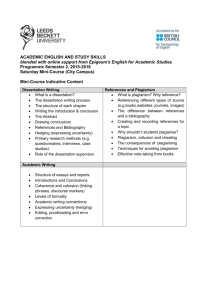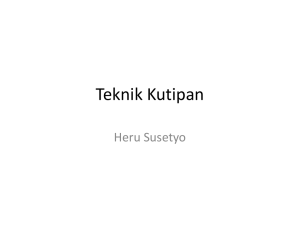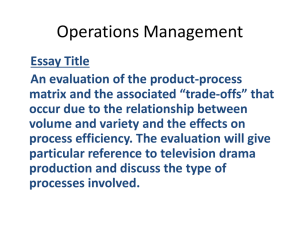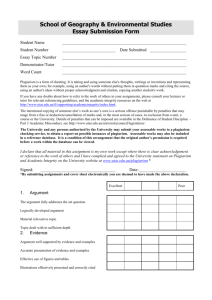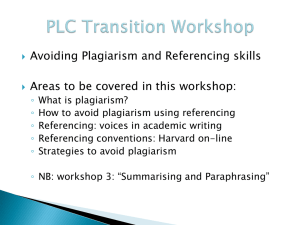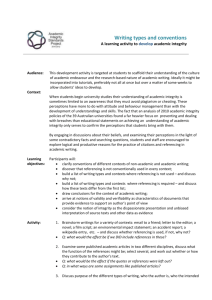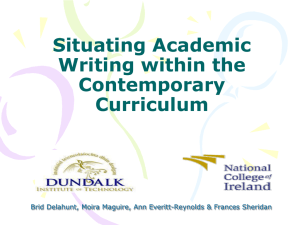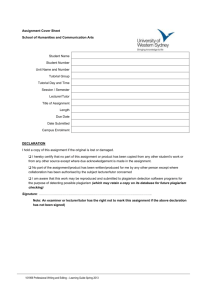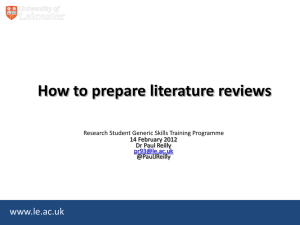HE Study Skills Quick guide - College Documents
advertisement
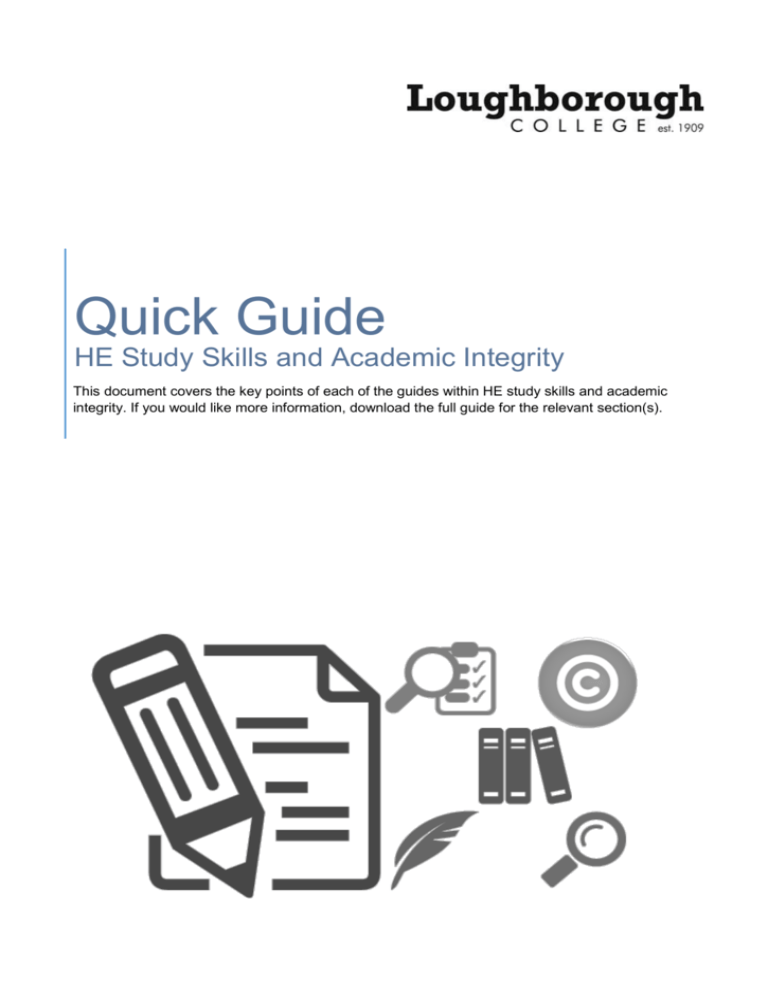
Quick Guide HE Study Skills and Academic Integrity This document covers the key points of each of the guides within HE study skills and academic integrity. If you would like more information, download the full guide for the relevant section(s). Contents page Referencing......................................................................................................................................... 2 Harvard referencing ......................................................................................................................... 2 APA referencing .............................................................................................................................. 3 Plagiarism and Turnitin........................................................................................................................ 4 Plagiarism........................................................................................................................................ 4 Turnitin ............................................................................................................................................ 4 Copyright............................................................................................................................................. 6 Research Methods .............................................................................................................................. 7 Finding information at Loughborough College ................................................................................. 7 Research approaches...................................................................................................................... 7 Research questions ......................................................................................................................... 8 Planning and writing ............................................................................................................................ 9 Report writing .................................................................................................................................. 9 Writing a literature review ................................................................................................................ 9 Writing a dissertation ..................................................................................................................... 10 Studying effectively ........................................................................................................................... 11 Time management ......................................................................................................................... 11 Improving memory ......................................................................................................................... 11 Successful group work................................................................................................................... 12 Academic poster design ................................................................................................................ 12 Summary........................................................................................................................................... 13 References........................................................................................................................................ 14 Loughborough College HE Study Skills: A Quick Guide 1 Referencing There are two styles of referencing that are in use at Loughborough College, Harvard referencing and APA referencing. If you are insure which referencing style you should be using contact your academic tutor or the tutor who has set your assignment. Harvard referencing Referencing in the Harvard system comes in two parts, the in text citation and the more detailed references at the end of your work. Citing within the text Whenever you refer to someone else’s idea, or quote from their work you should include their surname and the date of the publication. The most simple in text citation is to include the author and year of publication in brackets after the statement that you are referencing; (Bloggs, 2002). Quoting in the text When quoting sections of someone else’s work, in addition to their name as above, you should make sure the text is contained in quotation marks and include the page number, or numbers after the quote: Bloggs and Wright (2002) state, “This is a quote.” (p.15). References At the end of your work you should include a list of works referenced within your text. Depending on the format of the content being referenced you may have to include different information. This list should be alphabetised by the authors’ name, and in the event of multiple publications, their date. Referencing a book Books should include the author(s), the year of publication, the title of the book in italics and the city of publication and publisher. The edition of the book should be included if it has had multiple, otherwise it can be omitted. This is how you build up a reference for a book with a single author: Author’s name Year Title of the book Edition Bloggs, J.R., 2002. How to Cite Works. 3rd ed. Place of publication Publisher Manchester: Fictional Publishing. Bloggs, J.R., 2002. How to Cite Work. 3rd ed. Manchester: Fictional publishers. For information about how to cite books with multiple authors and other resources such as Journals, eBooks, Websites, YouTube and other online sources see the Harvard referencing guide. Loughborough College HE Study Skills: A Quick Guide 2 APA referencing Referencing in the APA system comes in two parts, the in text citation and the more detailed references at the end of your work. In text citation Whenever you refer to someone else’s idea, or quote from their work you should include their surname and the date of the publication. This can be done in a number of ways; For ideas - One or two authors should be cited in text with their surnames and the year of the publication in brackets. For quotation - When quoting sections of someone else’s work, in addition to their name and the year of publication, you should make sure the text is contained in quotation marks and include the page number, or numbers after the quote. References At the end of your work you should include a list of works referenced within your text. This list should be alphabetised by the authors’ name, and in the event of multiple publications, their date. Years of works are contained in brackets (2002) and names of publications are always in italic, however titles of articles are not. Another style element unique to the APA style referencing is using hanging indentation for references that span more than one line on the page. Bloggs, J.R., Bloggs, J.B., & Roberts S.B. (2002). Hanging Indentation in Evidence: - How to Cite Work with Really Long Titles. Manchester: Fictionally Long Named Publishers Public Limited Company. For information about how to cite other resources such as Journals, eBooks, Websites, YouTube and other online sources see the APA referencing guide. Loughborough College HE Study Skills: A Quick Guide 3 Plagiarism and Turnitin Plagiarism Plagiarism is when a student fails to reference work that is not their own. You must reference any sources that you use to inform your work. You must not only reference written text but also other media, such as illustrations, graphs, grids and any other work that you have not created. It is important to make sure that you clearly reference all of the sources that you have used within any work that you produce, using the correct referencing structure and making sure that all references are full and correct. There are different ways that you can plagiarise work, it is important that you are aware of these ways so that you can learn how to reference work properly and avoid plagiarism. Quotations You must always use speech marks to show that you are using someone else’s ideas and words. Depending on the length of the quote and the referencing system that you are using, you can use indentation to make it clear to the reader what is your work and what work you are quoting. Paraphrasing Paraphrasing is when you re-write someone else’s work by changing their sentence structure and wording. Paraphrasing is classed as plagiarism, you are making the idea look like it is your own, as you are not referencing that it is someone else’s work. Cutting and pasting Information taken from all sources must be properly referenced, this includes information taken from online sources. Inaccurate references It is very important that your references are correct and accurate, you must only reference books (and other resources) that you have read. Unintentional plagiarism Sometimes a student can plagiarise unintentionally, although the plagiarism is unintentional there could still be serious consequences for the student. Avoiding plagiarism The best way to avoid a situation where you have been found to plagiarise work this is to make sure that you have read the plagiarism policy and reference all sources correctly. If you are not sure how to do this contact the tutor who has set you the work. For more information on plagiarism and types of plagiarism refer to the resource “A guide to understanding plagiarism” Turnitin Turnitin is a way for students to electronically submit their work, electronically receive feedback and view an originality report of their work. At Loughborough College you can access your Turnitin submission link through LearnZone. Why is Turnitin used? Loughborough College HE Study Skills: A Quick Guide 4 A tutor may use Turnitin as a way to allow students to submit their submissions electronically. The tutor will set up a Turnitin submission through the relevant page on LearnZone. Submission via Turnitin allows a tutor to give in depth, online feedback straight onto the submission. A tutor may also choose to use the “Originality checker” feature of Turnitin, this will help them to identify if a submission has been correctly and completely referenced and will also help to highlight if the work, or aspects of the work, that are similar to other sources. The tutor may decide to share the originality report with each student, or they may only use it to inform their feedback on the submission. There is no right or wrong percentage of referenced material that each submission should contain, the tutor will use the percentage figure to help them to make a decision about how accurate the references are and whether there is any accidental plagiarism within the submission. For more information about Turnitin and how it can help you refer to the resource “A guide to understanding Turnitin” Loughborough College HE Study Skills: A Quick Guide 5 Copyright Copyright is the way that people’s work is protected. It is automatically created and applies to many different types of work, including music (the recording and the score), film, theatre and books as well as other types of works. Some facts about copyright, did you know? ● Copyright is the exclusive right to make copies, license or otherwise exploit an artistic ‘work’ ● There is no official registration system for copyright, it is automatically created and is an automatic right ● Copyright is an exclusive legal right given to the creator of the work Why is copyright important to me? Copyright infringement is a serious offense, it could lead to disciplinary action taken against you buy the college or legal action taken against you by the copyright holder. Whenever you use anyone else’s work you must always reference it, by doing this you are acknowledging that the work is not your own. How to make sure that you use other people’s work properly Make sure that you are familiar with the style of referencing that you have been asked to use. If you are not sure what style of referencing you are supposed to be following, ask your tutor. There are two referencing styles in use in Loughborough College, they are Harvard Referencing and APA referencing. There is a guide available for each of these referencing styles in the Study Skills section of the College website. What is Creative Commons? Creative Commons is a non-profit organisation that helps people to share their works and allow other people to use copyrighted works, with certain restrictions. There are different types of Creative Commons licences that the creator of a work can decide to license their work under. The symbol is the symbol used to represent Creative Commons. Using images in your work In your work you must only use images that you have permission to use. This usually means using images that are Creative Commons or photos that you have taken yourself. When you use a Creative Commons image you must always attribute the creator of the work, when attributing work you should hyperlink the creator’s name and link it to the original work. If your work is going to be printed out you should put the name of the creator next to the image in your work and then reference the hyperlink below the reference list. Loughborough College HE Study Skills: A Quick Guide 6 Research Methods Finding information at Loughborough College The Library & Learning Resources Centre opening times are: Term time: Monday–Thursday: 8.30am - 7.00pm Friday: 8.30am - 4.30pm Out of term time: Monday–Thursday: 9.00am - 12.30pm & 1.30pm - 5.00pm Friday: 9.00am - 12.30pm & 1.30pm - 4.30pm What is available in the Library? The Library has over 16,000 books, 100 print journals as well as access to electronic books, journals and resources for your college course. You can borrow up to 10 items at a time with your student card. Go to the online Library Catalogue to access these resources. How do I use the online Library catalogue? The online library can be accessed from anywhere you have an internet connection. Log in to the Student Dashboard and click on “Library LRC” in the bar at the top of the page or follow the Library link from the Student Links page on the Loughborough College website. You can search the catalogue to find books, eBooks, journals and eJournals. You can log into your library account to renew and reserve items online. To log into your account enter your username (college number) and leave the password blank. For more information about finding information at Loughborough College or using the library refer to the guide “Finding information at Loughborough College” Research approaches All research, whether qualitative or quantitative, requires interpretation and contextualisation by the researcher. Narrative statements or a series of figures will not give the answer to the research question or statement (hypothesis) by themselves. Therefore it is important to choose a research approach (or approaches) that will give the correct ‘type’ of data to answer your research question. Possible research approaches There are lots of research approaches that are available to use, a few are explained below. More information and different types of research approaches are covered in the “research approaches” guide. Focus group This is where a group of people discuss a particular problem, facilitated by the researcher. Structured interviews When using structured interviews, the questions are written beforehand and are strictly adhered to regardless of the answer. Loughborough College HE Study Skills: A Quick Guide 7 Semi-structured interviews This approach allows for the researcher to spontaneously build on answers given, allowing the base question to be answered but also elaborating on any areas which may impact on the research answer. Survey Surveys are an excellent way to reach a large number of people. This approach works if there is a clear idea of the questions that will elicit research to support the hypothesis. A mix of qualitative (open text fields) or quantitative (set questions and answers) can be used. Case study This approach is valuable when more in depth research is required and allows the researcher to investigate the issues in the place or time that they occur. The researcher will observe the participant and often will have follow up meetings to clarify or build on the information gained. For more information about research approaches guide refer to the guide “Research approaches”. Research questions A research question is a clear, concise, focused and arguable question which you build your research around. A research question is the basis for any dissertation research, all methodological features of the research come from the creation of these questions. How to construct a good research question Research questions should follow on from the statement of the research problem. Research questions should narrow content or methodological gaps in the literature. The research questions should be consistent with the title of the dissertation as well as the elements of the literature presented in the introduction. Example process for writing a good research question Choose a general topic that interests you Do some preliminary research on your chosen topic Keep your audience in mind Evaluate your question Consider where your question will take your research Guidelines Make sure that your question is clear, concise, focused and feasible You do not need any references for your research questions. For some dissertation research, only one research question is necessary, for others you may need multiple questions. If you are unsure whether you need one research question or multiple contact your academic tutor. For more information about research questions and how to form a strong research question refer to the guide “A guide to research questions”. Loughborough College HE Study Skills: A Quick Guide 8 Planning and writing Report writing A report is a highly structured form of writing, more structured than an essay or piece of reflective. It is designed so it can be read quickly, easily and accurately. Reports are written on a wide variety of subjects for many different reasons; before writing your report it must be clear the objectives for your report whether it is to communicate findings, inform decision makers, change public opinion or maintain development. Whatever the purpose of the report you must always think about who the intended audience for the report is and think about the ideas/results/findings they will be interested in. Stages in report writing The following stages should help you write your report: Planning Collecting information Organising and structuring your information Writing the first draft Checking and redrafting It is good practice to draw up your own outline structure for your report and set yourself a sensible timescale in which to complete your writing. For information about report layout, examples of report structure and an effective report writing process refer to the guide “A guide to report writing” Writing a literature review What is a literature review? A literature review is an evaluative and critical account of the published/accomplished research into a specific area of study. A good literature review effectively summarises, evaluates, analyses and synthesises ideas of others to support your own argument and ideas. It should justify the need for your research by highlighting a gap in the existing research. You should put forward a clear relationship to existing research, research that has not been done and your own research. A literature review should reveal the inconsistences and differences in the existing research, it should identify areas for further research or study and it should aim to gather a new perspective on a particular topic and to offer a context to the research problem/solution. A literature review will differ between subject areas It is important to be aware that different subjects/disciplines require a slightly different approach to writing a literature review. Your supervisor or tutor may have a certain method or preference to developing a literature review so you should check before you begin your writing up. Organisation and structure This could be led by personal choice, research led or supervisory led but the way you organise your work should first and fore mostly benefit you. You could contact your supervisor for more support on how to address your research project. You may want to organise your work by taking the following steps: 1. Introduce your research question, what is it? Why is it worth investigating? 2. Relate your question the existing research and the studies that you have highlighted as key texts. Loughborough College HE Study Skills: A Quick Guide 9 3. Briefly outline what your literature review will do; if it is a complex are of study outline why it is complex, explain that you will present previous research and which bits of it that you want to support or reject. 4. Explain why the methodologies in the previous research are important/different or the same as yours. 5. Describe studies in detail. 6. Compare and evaluate studies. 7. Discuss the implications of the studies and how you intend to build on them. For more information about writing a literature review, the approaches needed for different disciplines and models to use to help you write a literature review, refer to the guide “A guide to writing a literature review”. Writing a dissertation The dissertation is the final demonstration of the design, execution, and interpretation of any planned research project. A dissertation allows students to: Demonstrate that the plan for the research was carefully completed Explain how the findings were gathered and why Support the discussion, implications and conclusion of the research. Why should dissertation structure be important to me? It is important to structure and plan your dissertation carefully in order to guarantee that your arguments and observations are coherent and detailed and follow the flow of the work. It should take the reader from the beginning of the project process to the end and should be clear to the reader how you have come to the conclusions within your writing. Tips to Plan a successful dissertation Create and follow a specific plan for conducting your research, including the process for completing and organizing the dissertation, with input from your tutor/supervisor Use a checklist to arrange and monitor your tasks Work on your dissertation over time, adjusting the schedule for completing your tasks and writing specific sections of the dissertation according to your daily life and wellbeing. Set realistic goals with input from your tutor, work towards dates for completing your tasks and writing specific sections of the dissertation Select a dissertation topic that is interesting to you- remember it has to keep you interested over a long time. For more information about dissertation structure and effective dissertation planning refer to the guide “A guide to dissertation structure”. Loughborough College HE Study Skills: A Quick Guide 10 Studying effectively Time management Time management is the process of planning and allocating your time in accordance to the tasks that you have to complete. Studying at a HE Level means you have to manage your time accordingly. This could mean you have to balance your studies with employment and leisure. Without thinking about your time management you could find this difficult to do. However there are a number of different techniques that you can use to aid you which can help you prioritise tasks, projects or goals. Key tips Have regular breaks Breaks can help you re-gather your thoughts and re-energise. During your breaks you should try and drink plenty of water. Plan, but plan well Don’t make a plan for plans sake (this is procrastinating!). Make sure you create a plan with clear goals and outcomes Don’t try and do it all at once Your brain doesn’t work as well if you’re looking at the same thing, or trying to do the same task for hours on end Break your work into manageable chunks If it is an essay or report for example, there will be clear sections that you can break your assignment up into. By doing this is means you will achieve smaller but vital goals. For more information about how to manage your time effectively refer to the guide “Time management” Improving memory Your memory is one of your biggest assets, so improving it can help you with your study and development. There are many different ways to remember information and which one works best for you will be personal. Below are some techniques that can help you remember. Mnemonics A mnemonic is a memory aid that is used to help remember phrases or sequences. Example: Richard Of York Gave Battle In Vein used to remember the colours of the spectrum (Red, Orange, Yellow, Green, Indigo, Violet) Colour coding Colour coding your work can help you build connections between topics and help you remember the topics themselves. For example you may find it easier to link blue to yellow together rather than the content itself. Image association Similar to colour coding, it may be that a powerful image can help you relate to topic thus you can then make connections between the images. Creating a story Loughborough College HE Study Skills: A Quick Guide 11 If there is important information that you can’t seem to get into your head, imagining or creating a story is a great visual way to embed that information in your memory. Creating a song/rhyme Similar to using mnemonics, you can create a rhyme or a song to remember important facts. Try making it amusing or ridiculous. Making connections with funny instances will be easier than connections with the content itself. For more information about improving memory and learning styles refer to the guide “Improving memory”. Successful group work While studying you will be required to take part in group assignments. This will mean that you will have to work from 1-5 others (this could vary depending on the area of study) to create something together to submit. You may choose your own groups or this may be determined by your tutors. Regardless of this you will be required to work together as a team towards a common goal. How you divide the different aspects of the work up in your group will be up to you and your group members. Tips for successful group work Divide the work out Ensure that the work is distributed out. However this is, whether this is evenly or task based Write down what has been decided This could be a simply list or table with names and tasks alongside, or you can go one step further and take minutes for your meetings. Set realistic deadlines Once tasks have been divided up, ensure the group arrange a time a review where the members are up to with their tasks as a check that the group is moving towards or achieving their goals. If someone isn’t pulling their weight address as a group If the group feel there is one or more people who aren’t meeting their deadlines, but there seems to be no good reasons why, address this issue as a group with the individual(s) as there could be good reasons why this is. Use technology available to you If you can, use technology to support your group work. This can be for communication or sharing of work For more information about how to work successfully in a group refer to the guide “A guide to successful group work”. Academic poster design During your studies you may be asked to produce an academic poster. This usually consists of presenting some sort of information in a visual format. Depending on your area of study, the information you are asked to present will be different, this will mean the poster that you produce will vary from other subjects. For example if you’re studying on a Business related course, it could be a visualised business plan. Alternatively if you study Music, it could be you’re asked to research and display the history of music technology. Loughborough College HE Study Skills: A Quick Guide 12 Designing an academic poster There are four main things that you should think about when you are producing an academic poster, they are; Planning, Clarity, Images and Structure. Planning Plan your poster before you start creating it. There is nothing worse than filling your poster space and realising you need to fit more important things on. Planning means that you prioritise the main aspects and ensure they are the primary focus of your poster Clarity The first and most important thing that your poster is clear and understandable. If you are creating it as part of an assessment, the majority of the marks will be based around your research and communicating this across to the assessor. Images Be careful what images you use. There are a number of guidelines to do with copyright issues when it comes to images. Please read out copyright guidance for support with this. INSERT LINK Structure Although this is a visual representation of your work, it still needs to have a logical structure. It may that you want the assessor to read the poster in a linear fashion (from top to bottom) or you may wish them to follow a different path. You could number the different areas of your poster to ensure your tutor knows exactly which path to follow. For more information about academic poster design refer to the guide “Academic poster design”. Summary This guide covers the key points of all of the guides within HE study skills and academic integrity. This guide is useful as a recap, refresher or starting point for HE study skills. For more information use the full guides available through the College website. Loughborough College HE Study Skills: A Quick Guide 13 References Belbin, M. 1981. Management Teams. London; Heinemann. ISBN 0-470-27172-8. Creative Commons, 2013. About the Licenses. [Online] Available at: http://creativecommons.org/licenses [Accessed 24/01/2014]. Cousin. Glynis,. 2009. Researching Learning in Higher Education. Routledge. UK Covey, S. R. 1989. The 7 habits of highly effective people: Restoring the character ethic. New York: Simon & Schuster. Fact sheet P-01: UK Copyright Law. The UK Copyright Service. [Online] Available at: http://www.copyrightservice.co.uk/copyright/p01_uk_copyright_law [Accessed on 19/12/2013] Intellectual Property Office. 2012. Copyright [online] Available at: http://www.ipo.gov.uk/copy.htm [Accessed on 19/12/2013] Juran J.m,. 1988. Quality Control Handbook, 4th edition., McGraw-Hill. Persky, Joseph. 1992. Retrospectives: Pareto's Law. Journal of Economic Perspectives, 6(2): 181192. Sampson, James P. Jr., 2012. A Guide to Quantitative and Qualitative Dissertation Research. [Online] Available at: http://diginole.lib.fsu.edu/edpsy_faculty_publications/1/. [Accessed 14/02/2014] The Writing Center. 2009. How to write a research question. Available: http://writingcenter.gmu.edu/?p=307. [Accessed 20/02/14]. University of Oxford. 2013. What is plagiarism?.[Online] Available at: http://www.ox.ac.uk/students/academic/goodpractice/about/. [Accessed 14/02/2014]. Loughborough College HE Study Skills: A Quick Guide 14

